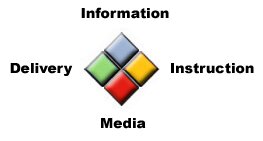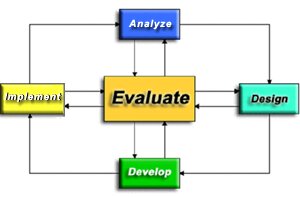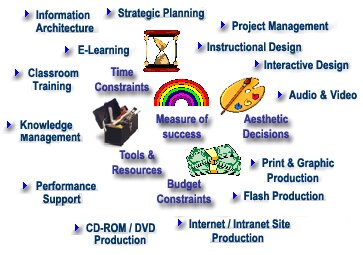|
 Design Process Design Process
The Design Process
|
"I hear and I forget. I see and I remember.
I do and I understand."
Confucius
|
Instructional design is the systematic specification of instruction to include: objectives, presentation, activities, materials, guidance, feedback and evaluation. It applies learning principles to decisions about information content, instructional method, use of media and delivery system. The goal is to ensure instructional quality, effectiveness, efficiency and enjoyment.

The purpose of instructional design is to maximize the value of instruction for the learner — especially the learner's time. Instruction provides a concentration of life-experience into a shortened, optimized time frame and provides feedback to ensure that learning objectives are actually being achieved. Ideally, instruction allows the knowledge, wisdom and skills of an instructor-author to be personally communicated or demonstrated to a learner.
The Value Proposition
With the ever-growing demand for information, entertainment and learning, a cliche has emerged that says, "content is king." On one level this cliche refers to the trend to turn all content into a commercial commodity. On another level, this phrase expresses a value formula. That is, the urgent need for meaningful content to dynamically drive the information revolution.
The continuing information revolution is essential for economic growth and social development, but is it the final process? What is the rest of the story — this drive for meaningful content, the need to construct meaning — when it comes to education and training? From our point of view, when talking about learning-content (as distinct from information-content or entertainment- content) the rest of this value formula is the value-added by the science and technology of instructional design.
Instructional design is the means by which the demand for learning-content can be meaningfully and effectively satisfied. Learners may only be able to express their learning needs and interests in terms of identifying subject-matter topics and not yet be sophisticated in terms of demanding quality instruction or quality delivery. Yet the greater need (economically, culturally and personally) is for that learning-content to be delivered in instructionally effective and cost efficient ways. It is this "instructional packaging" which gives the content multiples of greater value. This is the value proposition of instructional design, and underlying market need of E-Learning.
Design Workflow: ADDIE
The most common model of Instructional System Development (ISD) is ADDIE, which stands for Analyze, Design, Develop, Implement and Evaluate. It follows a classic "waterfall" type of development model with each phase sequentially flowing into the next.

- Analysis
— involves needs analysis, job analysis, and task analysis. Output of this phase should include instructional goals. The definition of meaningful, job relevant and achievable instructional objectives drives the next stage of design.
- Design
— involves outlining the strategy for how to reach the instructional goals determined during the Analysis phase. Design decisions focus on: content selection, instructional strategy and methods, media and materials, and a variety of delivery system options. The design specification, often including layout drawings, templates or prototypes, then drives the next stage of development.
- Development
— entails building all forms of instruction necessary to execute the learning strategy and any supporting documentation. Development includes instructor activity guides and materials appropriate for the mode of delivery. This may include traditional classroom instructor-led presentation and activities, web-based training tutorials, online virtual classroom presentation, simulation and practice, media development (graphics, animation, audio and video) and so forth. In every instance, development is tested and evaluated to validate that the activities and materials are ready to use by the learner.
- Implementation
— refers to the actual delivery of instruction in a way that ensures student mastery of the learning objectives and transfer of necessary skills to the job setting.
- Evaluation
— measures the effectiveness and efficiency of the instruction. Formative assessment occurs within and between phases, while summative assessment occurs at the end of the process.
|
The value of a workflow model, like ADDIE, is that it provides a project management framework for coordinating a team's activities and the contributions of each team member. Milestone events mark the end of one phase and the beginning of the next phase.
The important project management task is to ensure that everyone is committed to the same goals, and understands the milestones at which various project decisions will be finalized — decisions to which the team and individual members will be accountable. The ADDIE model (or one like it) provides such a valuable project roadmap.
|
 |
The Limitations of ADDIE
The most generally acknowledged criticism of ADDIE is that the real world of design and development does not neatly fit into a box. There is a dynamic interplay between writing meaningful objectives, designing effective presentation, and developing engaging interactivity. So back-and-forth adjustments, rewrites and fixes occur as an integral dynamic process of the build. It is a cyclic, iterative process — not just a linear process. The danger is that this iterative workflow, so necessary to achieve the full value and impact of the instructional design, may become subordinated to the linear mental framework of ADDIE.
One of the goals of ADDIE is to ensure the role of evaluation. Often the model will be presented with evaluation as the centerpiece component — to emphasize that the evaluation process is ongoing and integral to each phase.

The problem, however, is that the evaluation criteria (measure of success) are only gestured to by ADDIE but not explicitly defined. Design and development phases can be completed but this will not guarantee an instructionally sound result. It is for this reason that we have proposed the Cognitive Design model — as a principle-model to augment the procedural-workflow model of ADDIE. Decisions about Information, Instruction, Media and Delivery System are anchored by applying specific principles of cognitive learning.
These instructional decisions and cognitive design principles provide the basis for a set of explicit, results-based, evaluation criteria. The template of the design model is described in detail in the following sections: "What is Cognitive Design?," "Cognitive Design Principles" and "The Process Paradigm."
Key Design Issues are Project Issues
Some of the most important forces determining design choices come from constraints on the available resources: money, time, tools, and manpower.

There also must be a politically sensitive, yet effective, team approach to resolving aesthetic and quality decisions — decisively and authoritatively. Otherwise the design process can be undermined by aesthetic indecision, unrealistic expectations or partisan agendas. Finally, there must be a project management definition (or measure) of success that incorporates meaningful instructional impact.
An instructional designer must either play the role of a project manager, or work closely with a project manager, in order to be aligned with these design constraints. Just as a project manager must be aligned with, and honor, the learning principles of the Cognitive Design model, the instructional designer must be aligned with, and honor, the realism and pragmatism of project constraints. We have described added strategy to accomplish this in a following section called "Workflow."
Clarity out of chaos
If all of the design issues of instructional development were to be put on the table, it could look like this bewildering and chaotic array of complexity:

Yet this is precisely the array of issues that an instructional designer must be able to understand and constructively manage. Sponsors, managers and supervisors need to understand the "big picture" view to make resource decisions. Project managers, designers, developers, programmers and subject-matter specialists need detailed views — and guidance on how their piece fits into the whole.
The only way to avoid being overwhelmed by too much complexity is to have a clearly defined roadmap — with the sense of direction anchored by goals, principles and processes. That framework is what the Cognitive Design Process model combined with ADDIE is structured to provide.

|
The Design Process
|
 |
|
|



